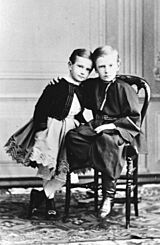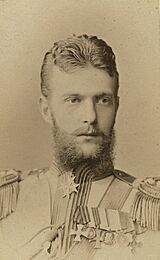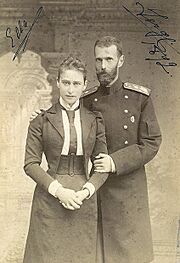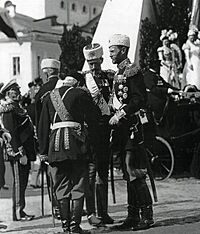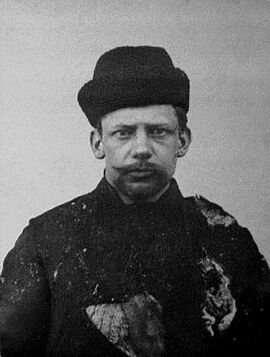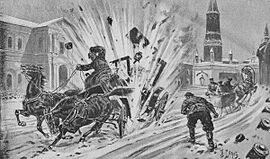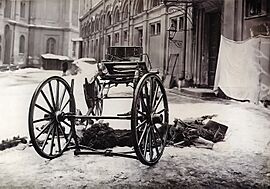Grand Duke Sergei Alexandrovich of Russia facts for kids
Quick facts for kids Grand Duke Sergei Alexandrovich |
|||||
|---|---|---|---|---|---|
| Grand Duke of Russia | |||||
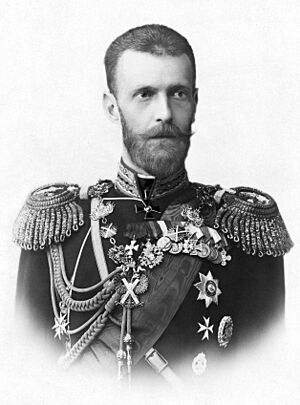
Photograph by Sergey Levitsky, c. 1894
|
|||||
| 48th Governor-General of Moscow | |||||
| In office 1891 – 17 February 1905 |
|||||
| Monarch | Alexander III Nicholas II |
||||
| Preceded by | Vladimir Dolgorukov | ||||
| Succeeded by | Alexander Kozlov | ||||
| Born | 11 May 1857 Catherine Palace, Tsarskoye Selo, St. Petersburg, Russian Empire |
||||
| Died | 17 February 1905 (aged 47) Moscow Kremlin, Moscow, Moscow Governorate, Russian Empire |
||||
| Burial | Chudov Monastery (original burial place) Novospassky Monastery, Moscow (since 1995) |
||||
| Spouse |
Princess Elisabeth of Hesse and by Rhine
(m. 1884) |
||||
|
|||||
| House | Holstein-Gottorp-Romanov | ||||
| Father | Alexander II of Russia | ||||
| Mother | Marie of Hesse and by Rhine | ||||
| Religion | Russian Orthodox | ||||
Grand Duke Sergei Alexandrovich of Russia (Russian: Сергей Александрович; 11 May 1857 – 17 February 1905) was a very important member of the Romanov dynasty. He was the fifth son of Emperor Alexander II of Russia. Sergei was influential during the reigns of his brother, Emperor Alexander III of Russia, and his nephew, Emperor Nicholas II. Nicholas II was also his brother-in-law, as Sergei married Elisabeth, who was Nicholas's wife's sister.
Sergei's education helped him develop a lifelong love for culture and the arts. Like other male members of the Romanov family, he joined the military. He fought in the Russo-Turkish War of 1877–78 and was recognized for his bravery. In 1882, his brother, Tsar Alexander III, made him commander of the 1st Battalion Preobrazhensky Life Guard Regiment. He held this position until 1891. In 1889, he became a major general. In 1884, Sergei married Princess Elisabeth of Hesse and by Rhine, who was a granddaughter of Queen Victoria. They did not have their own children. However, they became guardians for the two children of Sergei's brother, Grand Duke Paul Alexandrovich of Russia: Grand Duchess Maria and Grand Duke Dmitri. Grand Duke Sergei and his wife also encouraged the marriage of his nephew, Tsar Nicholas II, to Princess Alix of Hesse, who was Elizabeth's younger sister.
From 1891 to 1905, Grand Duke Sergei served as the Governor-General of Moscow. His reputation was damaged because he was partly blamed for the Khodynka Tragedy. This happened during the celebrations after Emperor Nicholas II's coronation. As Governor of Moscow, he followed very strict rules. This made him a figure that many people either strongly supported or strongly disliked. He resigned from his role as Governor on 1 January 1905. However, he remained in charge of the Moscow Military District. He was targeted by a group called the SR Combat Organization. He was killed later that year by a terrorist bomb at the Kremlin during the 1905 Russian Revolution.
Contents
Early Life of Grand Duke Sergei
Grand Duke Sergei Alexandrovich was born on 11 May 1857. He was born in the Catherine Palace at Tsarskoye Selo. He was the seventh child and fifth son of Alexander II of Russia. His mother was Maria Alexandrovna, who was Princess Marie of Hesse and by Rhine.
Sergei spent his early years with his younger brother Paul. They were very close. They also spent time with their sister at Livadia Palace in Crimea, at Tsarskoye Selo, and at the Winter Palace in Saint Petersburg. When Sergei was born, his mother was not very healthy. She was not very affectionate, except with her daughter. However, her three youngest children, Marie, Sergei, and Paul, were close to her and to each other. Marie loved Sergei and called him "an exceptionally nice young man."
As his mother's health declined, they spent long periods abroad. They visited Seeheim-Jugenheim and spent winters in the South of France. In April 1865, a family tragedy occurred. Sergei's older brother and godfather, Nicholas, who was supposed to become the next emperor, died in Nice. As a child, Sergei was shy and loved to study. He was also very religious, influenced by his mother.
From the 1870s, Sergei and Paul stayed in Russia for their studies. They were expected to have military careers. However, their tutor, Admiral Arseniev, also encouraged Sergei's talents in languages, art, and music. He spoke several languages fluently. He even learned Italian to read Dante's works in their original language. His interest in Italian art and culture grew as he got older. He was a good painter and played the flute in an amateur orchestra. He also enjoyed acting. He loved learning about Russia's early history, culture, and traditions. He enjoyed reading and met many famous Russian writers, like Tolstoy and Dostoevsky.
Military Career and Public Service
Grand Duke Sergei Alexandrovich began his military career early. From birth, he was a colonel-in-chief of the 38th Tobolsk Infantry Regiment. He also became colonel-in-chief of the 2nd Battalion Guards Rifles. On his twentieth birthday in 1877, he took a solemn oath to the Emperor. A planned educational trip was postponed because the Russo-Turkish War of 1877–78 began. Sergei fought in the war with his father and brothers. He spent most of his time serving under the Tsarevich Alexander in southeast Romania. He was promoted to colonel. In October, after the battle of Meyk, the Emperor gave him the Order of St George for his courage in battle. In December 1877, Sergei returned to Saint Petersburg with his father.
After his mother's death in 1880, his father, Alexander II, was assassinated by terrorists in March 1881. Sergei was in Italy at the time. Three months later, in June 1881, the Grand Duke visited Palestine. He went with his brother Paul and his cousin Grand Duke Constantine Constantinovich. They visited Jerusalem and other holy sites. Sergei helped create the Imperial Orthodox Palestine Society. This group worked to maintain Orthodox shrines in the Holy Land and help Russian pilgrims. He became its chairman, and this role was very important to him.
From 1882, Sergei's military career grew. On 15 January 1882, his brother, Alexander III, made him commander of the 1st Battalion Preobrazhensky Life Guard Regiment. This was an elite regiment. He held this command until 1891. In 1889, he was promoted to major general. In 1891, his brother the Emperor appointed him Governor-General of Moscow.
Personality and Interests
At twenty-six, Grand Duke Sergei was reserved, smart, well-read, and refined. He was over six feet tall and very slim. He had short hair and a neat beard, which made him look impressive. When Consuelo Vanderbilt, who was the Duchess of Marlborough, met him, she thought he was "one of the most handsome men I have ever seen." His brother-in-law, Ernest Louis, Grand Duke of Hesse, described him as "tall and fair with delicate features and beautiful light green eyes." He was very aware of himself and often held himself very stiffly.
Sergei was known for his strong religious faith. He was very interested in Russian antiques and art treasures. He also enjoyed archaeology, music, and acting. He sometimes led meetings of the Archaeological Congress. He was shy and reserved, and he did not hide his disapproval of what he saw as loose behavior in society. He found it hard to deal with disagreement and could easily lose his temper. In his home, he demanded neatness, order, and discipline. He expected to be obeyed.
His niece, Marie, Queen of the Romanians, remembered him as "Dry, nervous, short of speech, impatient." She added, "but for all that we loved him, felt irresistibly attracted to him, hard though he could be." Many other family members also wrote good things about him in their memories.
Marriage and Family Life
In 1881, there were talks about Sergei marrying Princess Caroline Mathilde. However, Sergei chose Princess Elizabeth of Hesse as his bride. She was a daughter of Ludwig IV, Grand Duke of Hesse and by Rhine and Princess Alice of the United Kingdom. Elizabeth was also the older sister of Alix of Hesse, who later became the Empress of Nicholas II of Russia. Sergei and Elizabeth were cousins and had known each other for a long time. Elizabeth first said no to his marriage proposal. Queen Victoria, Elizabeth's grandmother, was against the marriage because she had anti-Russian feelings. However, Elizabeth and her sisters were allowed to choose their own partners.
After they spent time together in Darmstadt in September 1883, Elizabeth agreed to marry him. Their engagement was announced on 26 February 1884. When she married, Princess Elizabeth took the name Grand Duchess Elizabeth Feodorovna of Russia. The wedding took place on 15 June 1884 in the Winter Palace.
They spent their honeymoon at Ilinskoye, Sergei's country estate near Moscow. He inherited it from his mother. The couple later lived in Saint Petersburg in a mansion called Sergeivsky Palace. They also had a villa called Ferme at Peterhof. They often entertained guests at Ilinskoe during the summer. They also had Usovo, a large house with modern heating that Sergei built.
The couple was close to Emperor Alexander III and Maria Feodorovna. The Tsar trusted Sergei more than his other brothers. In 1886, Alexander III made Sergei commander of the Preobrazhensky Life Guard Regiment. He also asked Sergei to introduce the Tsarevich (the future Nicholas II) to army life. In 1887, Sergei and Elizabeth represented Russia at Queen Victoria's Golden Jubilee. In 1888, they went to the Holy Land for the opening of the Church of Mary Magdalene in Jerusalem. This church was built in memory of Empress Maria Alexandrovna. By 1892, Sergei knew they would not have children. He made a will naming his brother Paul's children as his heirs after his and his wife's deaths.
Governor of Moscow
In spring 1891, Emperor Alexander III appointed Sergei as governor general of Moscow. This was a great honor. Grand Duke Sergei accepted the role with some hesitation. He had hoped to stay longer in command of the Preobrazhensky Regiment, where he was well-liked. He and his wife also enjoyed their quiet life in Saint Petersburg.
As Governor-General of Moscow, Sergei was only answerable to the emperor. He was a strict leader who believed in a strong government. His time as governor began with some controversial decisions. He ordered the expulsion of many people from Moscow. This made him very unpopular among some groups. However, more traditional citizens were pleased with his policies. The wealthy people and merchants of Moscow disliked him because he was direct and sometimes lacked tact. He tried to fight business fraud and enforce strict rules.
Despite some unpopular decisions, he greatly improved living conditions in the city. He was very dedicated to his duties. His niece remembered that "Even in the country when he was supposed to be resting, he was constantly receiving couriers from Moscow." He paid close attention to details and personally handled matters that others might have left to assistants. He punished corruption and fraud. Sometimes, he would go around the city secretly to see conditions for himself. In private, he and his wife were concerned about the poverty in Moscow and the countryside. They often discussed ways to make things better.
Sergei was very involved with welfare organizations and charities. He was chairman or patron of many of them. For example, he led the Moscow Society for the Care of Blind Children. He also supported the Society for Homeless Children. He was a patron of universities and various aid funds. He was also chairman of the Academies of Arts and Science, the Moscow Archeological Society, and the Russian Musical Society, among others.
The Khodynka Tragedy
Tsar Alexander III died in 1894, and his son Nicholas II became the new Emperor. Grand Duke Sergei and his nephew Nicholas II had a close relationship. This bond grew stronger when Nicholas II married Princess Alix of Hesse. She was the younger sister of Sergei's wife, Elizabeth. Sergei and Elizabeth had helped arrange this marriage.
The coronation ceremonies for the new Emperor and Empress took place in Moscow, as was tradition. As Governor General of the city, Sergei was in charge of organizing the events. He even introduced electric lights to Moscow for the celebrations. Towards the end of the festivities, gifts were to be given to the public. This event was held at Khodynka Field, on the outskirts of Moscow. This field was usually a military training ground and had many ditches. Despite this, Sergei approved the plans. A huge crowd of almost half a million people was expected. However, only a small number of Cossacks and police were sent to keep order.
Early on 30 May 1896, families gathered outside the field. They watched carts filled with beer and gifts. Around 6 AM, a rumor spread that the booths had opened and gifts were being given out. Suddenly, the huge crowd rushed forward towards the booths. Many people fell or slipped on the uneven ground. Hundreds were crushed and trampled. Others suffocated in the chaos. The police were too few to stop the disaster. One thousand three hundred people died, and twice that number were seriously injured.
Grand Duke Sergei was blamed for the tragedy because he was the Governor-General. He was held responsible for the lack of planning. However, he did not fully accept his part of the blame. He blamed others, including the head of the Imperial Court Ministry. Sergei also did not go to the scene of the incident or attend the victims' funerals. This made his public image worse, even though he was deeply saddened by the disaster.
After the tragedy, some members of the Romanov family wanted to cancel the remaining celebrations. However, Sergei and his brothers believed that a historic event like a coronation should not be interrupted. They felt that the crowds who had traveled far should not be disappointed. They also thought that events for foreign guests should continue as planned. There was also disagreement about whether Grand Duke Sergei should resign. In the end, the Tsar did not support a full investigation. The Chief of Police was dismissed, but Grand Duke Sergei kept his position.
The night of the tragedy, Tsar Nicholas II attended a ball. This was for diplomatic reasons. However, his reputation also suffered because people thought he lacked sympathy for the victims.
Assassination and Legacy
After resigning as Governor, Grand Duke Sergei moved to the Neskuchnoye Palace with his wife and foster children. Soon after, they moved to the Nicholas Palace inside the safe walls of the Kremlin. Sergei took all the safety measures his detectives advised. He and his wife rarely went outside. At home, they only saw their closest friends. Sergei believed that if it was God's will, no attack on his life would succeed. He also believed that if it was God's will, no security could prevent it. One safety measure he took was for his assistants. He no longer allowed them to travel with him.
On 15 February 1905, the family went to a concert at the Bolshoi Theatre. It was a charity event for Elizabeth Feodorovna's Red Cross. A terrorist group, the Socialist Revolutionary Party's combat detachment, planned to kill him that day. However, one of their members, Ivan Kalyayev, saw the children in Sergei's carriage. He decided to cancel the attack. Killing the Grand Duchess and the children would have caused widespread fear. It would have also set back the revolutionary cause for years.
On 17 February, after lunch with his wife, Sergei left alone for the Governor General's mansion. He had refused to take his assistant, Alexei, because Alexei was married and a father. The Grand Duke's recognizable carriage, pulled by two horses, alerted the terrorist. Ivan Kalyayev was waiting in the Kremlin with a bomb wrapped in newspapers.
Just before 2:45 PM, Sergei's carriage passed through the gate of Nikolskaya Tower of the Kremlin. It turned the corner into Senatskaya Square. From only about 4 feet away, Ivan Kalyayev stepped forward. He threw a nitroglycerin bomb directly into Sergei's lap. The explosion destroyed the carriage, and the Grand Duke died instantly.
The carriage horses bolted towards the Nikolsky Gate. They dragged the front wheels and the coachbox with them. The driver, Rudinkin, was semi-conscious. He was rushed to the hospital but died three days later. Kalyayev, who expected to die in the explosion, survived. He was immediately arrested, sentenced to death, and executed two months later. The Grand Duchess rushed to the scene of the explosion. She was shocked but calm. She gave instructions and knelt in the snow to help gather Sergei's remains. His remains were placed on a stretcher and covered with an army coat.
Aftermath and Reburial
After the Grand Duke's death, Grand Duchess Elizabeth Feodorovna was deeply affected. She left the royal family and founded the Russian Orthodox convent of Martha and Mary. There, she dedicated herself to helping Moscow's poor and suffering. One of the duties of the sisters at the Martha and Mary convent was to make an annual trip to the church built in memory of the Grand Duke. Elizabeth Feodorovna was murdered during the Russian Civil War in 1918. Her body was later buried at the Church of Mary Magdalene on the Mount of Olives.
Grand Duke Sergei's body was first buried in a crypt of the Chudov Monastery within the Moscow Kremlin. A memorial cross, paid for by public donations, was put up where he was killed in 1908. After the Romanov family lost power, the cross was destroyed.
Chudov Monastery was torn down in 1928. The Presidium of the Supreme Soviet building was built on its site. The Grand Duke's burial crypt was in a courtyard of that building, which was used as a parking lot. In 1990, workers in the Kremlin found the blocked entrance of the burial vault. They examined the coffin and found the Grand Duke's remains. They were covered with his military coat, decorations, and an icon. In 1995, the coffin was officially dug up. After a special prayer service, it was reburied in a vault of the Novospassky Monastery in Moscow on 17 September 1995.
On 4 May 2017, Sergei's memorial cross was restored. President Vladimir Putin and Patriarch Kirill of Moscow attended the ceremony.
|
See also



